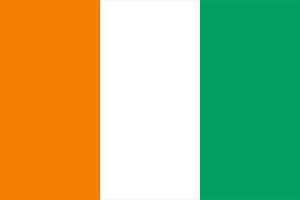
| Colors | HEX Code | RGB | CMYK |
|---|---|---|---|
| Orange | #F77F00 | 247, 127, 0 | 0, 49, 100, 3 |
| White | #FFFFFF | 255, 255, 255 | 0, 0, 0, 0 |
| Green | #009E60 | 0, 158, 96 | 100, 0, 39, 38 |
The flag of Côte d’Ivoire, or Ivory Coast, is made of three equal vertical stripes colored orange to the left, white in the middle, and green to the right.
Meaning of the Côte d’Ivoire flag
The flag of Ivory Coast has vertical stripes to represent the young people striving for development. The orange stands for dynamic national growth and the white is a symbol of peace, purity, and unity of all citizens. The green is the color of hope for the future. Unofficially, the green stands for the forests of the country and the green landscapes, and the yellow represents the Savannas.
History of the Côte d’Ivoire Flag
The Ivory Coast was a French colony. Like many other African colonies, it was given the choice to become autonomous, completely independent, or stay part of the French territory. The Côte d’Ivoire chose to become a republic in 1958. The prime minister who worked in France admired France and its culture and history, so he sought a flag that resembled the French flag while keeping the African identity of the country visible. The national flag was officially adopted on December 3, 1959, and remained the same without changes when complete independence was acquired on August 7, 1960. It was meant to be distinctive from neighboring nations’ flags that chose the Pan-African colors. The flag has witnessed no changes since it was adopted in 1959.